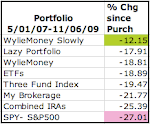It is time to confirm the fund I will add to the WylieMoney slowly portfolio on the first down day in September. When I researched the best no-load, no-fee mutual funds in 20 different categories available through Etrade with low initial and additional investment minimums last winter,
STSCX Stratton Small Cap Value Fund looked like
the best Small Cap Value fund at the time.
Is this still the case?
The answer is no and the reason is frustrating. The Stratton Small Cap Value Fund is no longer a Small Cap Value fund. It has moved into the Blend category. I will be adding a Small Cap Blend fund later, so I have to look around for a value fund.
When I search for no-load, no fee Small Cap Value funds available through Etrade, the choice is clear. But there are complications.
The choice is
Bridgeway Small-Cap Value N BRSVX. It is the only 5 star offering. It has trounced the other funds available over the last three years almost 2 to 1 earning 22.13% annually compared to 11.18%-15.10%. It has a low 49% turnover ratio (low for small cap value funds). It has very low for its category expense ratio of 0.77%.
So what are the complications, you might ask?
Well, I actually own this fund and I can tell you that Etrade has the additional minimum contributions for this fund wrong. The minimum through an AIP is $100. I actually contacted Bridgeway and they confirmed the information on Morningstar's site:

$100 is the maximum AIP contribution limit I set for my hypothetical portfolios, but Etrade has this set up with a $500 maximum in their web interface:

Read
here about my adventures getting Etrade to fix this for other funds I own. I actually got Etrade to set up a low AIP program for me for this fund, so I am able to make regular contributions into this fund in increments as small as $100 despite the fact that their online interface shows a minimum investment amount of $500.
So I am picking this fund for the WylieMoney Slowly hypothetical portfolio, despite the hypothetical rage I will feel having to contact Etrade to get them to fix yet another instance of the same issue with their interface that I have reported to them several times already.
In this case, the Bridgeway fund is so much better than its peers, it is worth the hassle... 'hypothetically.'
So on the first day in September that Small Cap Value funds take a beating, I will add BRSVX to the WylieMoney Slowly portfolio.
 Even on down days now, the WylieMoney portfolio is holding up. The 1.27% increase for the week was way better than the S&P 500 ETF, SPY which only gained 0.4%. Year to date, the WylieMoney portfolios have pulled even farther ahead of the mostly index fund portfolios that had, at one time, been in the lead.
Even on down days now, the WylieMoney portfolio is holding up. The 1.27% increase for the week was way better than the S&P 500 ETF, SPY which only gained 0.4%. Year to date, the WylieMoney portfolios have pulled even farther ahead of the mostly index fund portfolios that had, at one time, been in the lead.













































